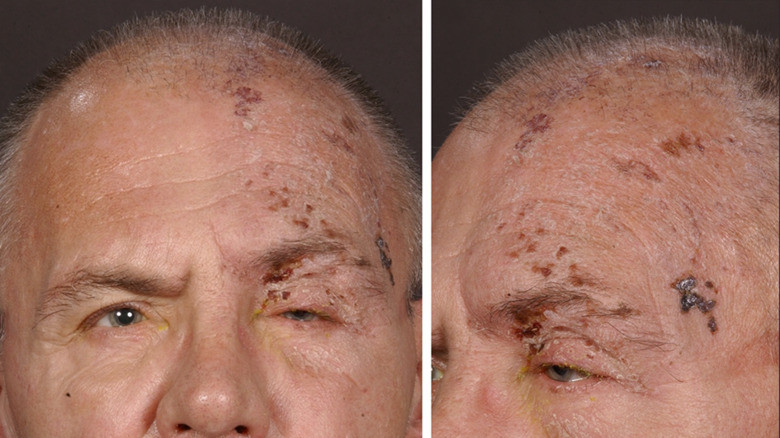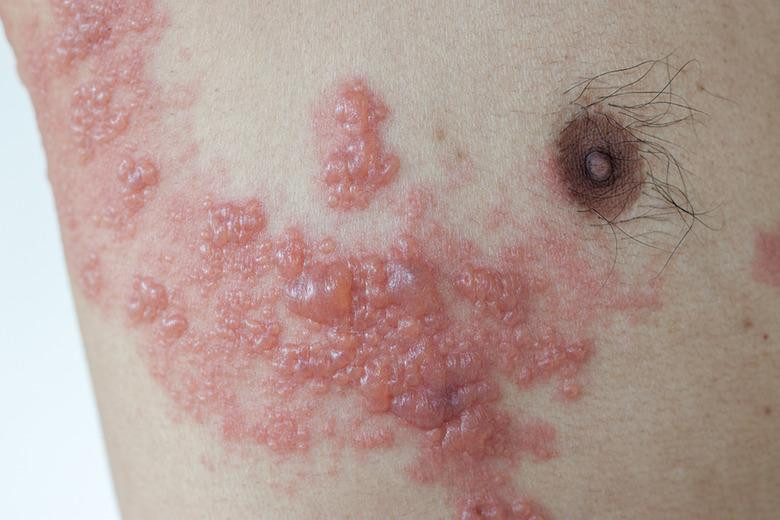Definisi
Herpes zoster adalah suatu penyakit yang disebabkan oleh infeksi Varicella Zoster Virus (VZV). Virus ini dapat menginfeksi berbagai saraf, termasuk saraf kulit di dekat mata, sehingga biasa disebut herpes zoster oftalmika. Sebagian besar orang di dunia memiliki kekebalan terhadap virus ini, namun memiliki kemungkinan untuk mengalami infeksi ulang atau reaktivasi. Dari seluruh kejadian herpes zoster, herpes zoster oftalmika terjadi pada 10-15% penderita.
Penyebab
Herpes zoster oftalmika disebabkan oleh Varicella Zoster Virus (VZV). Virus ini satu kelompok dengan Herpes Simplex Virus (HSV), virus yang menyebabkan penyakit herpes. Jika virus ini menginfeksi manusia, akan muncul gejala yang disebut sebagai cacar air, yaitu lenting di seluruh tubuh, yang disertai demam. Infeksi ini dapat membaik dengan sendirinya karena sistem kekebalan tubuh yang bekerja. Namun, virus VZV tidak mati, tetapi tidak aktif atau “tertidur” di saraf di tulang belakang. Pada kondisi tubuh dengan kekebalan baik, virus ini akan tetap pada keadaan tidurnya. Namun, jika kekebalan tubuh menurun, virus ini akan kembali aktif dan pada umumnya menginfeksi saraf-saraf yang sejalan dengan tempat bersarangnya. Akibatnya, saraf tersebut mengalami peradangan dan berpotensi rusak.
Pada beberapa kejadian, saraf yang terserang menerima rangsang dari kulit di sekitar mata serta kornea (selaput bening yang melapisi selaput pelangi mata). Saraf tersebut adalah cabang pertama saraf trigeminal (dinamakan sesuai dengan tiga cabangnya; dua cabang lainnya mempersarafi kulit wajah dekat rahang atas dan bawah). Hal inilah yang kemudian menyebabkan herpes zoster oftalmika.
Penurunan kekebalan tubuh yang dapat menyebabkan herpes zoster oftalmika dapat berupa penyakit yang menyerang sistem kekebalan seperti HIV/AIDS, atau terapi yang menurunkan kekebalan tubuh seperti terapi pada penyakit autoimun seperti lupus eritematosus sistemik (LES), rheumatoid arthritis (RA), dan sebagainya. Tidak hanya itu, penurunan sistem kekebalan tubuh juga dapat terjadi akibat penuaan dan stres psikologis yang cukup berat. Trauma langsung kepada saraf tempat bersarangnya virus VZV tersebut juga dapat menyebabkan herpes zoster.
Faktor Risiko
Faktor risiko herpes zoster oftalmika adalah kemampuan virus untuk menginfeksi tubuh serta sistem kekebalan tubuh sendiri. Angka kejadian herpes zoster oftalmika, seperti herpes zoster lainnya, meningkat seiring dengan penuaan, dengan risiko tertinggi pada usia di atas 60 tahun.
Selain itu, kondisi-kondisi yang menyebabkan penurunan sistem kekebalan tubuh, seperti HIV/AIDS, sangat mempengaruhi kejadian herpes zoster. Orang dengan HIV/AIDS memiliki risiko 15 kali lebih tinggi untuk mengalami herpes zoster dibandingkan dengan orang yang tidak memiliki HIV/AIDS. Tidak hanya itu, orang dengan HIV/AIDS juga lebih sulit sembuh dari herpes zoster dan kemungkinannya untuk mengalami komplikasi jauh lebih tinggi.
Terapi yang menurunkan sistem imun tubuh, seperti terapi pada penyakit-penyakit autoimun, dapat menjadi faktor risiko. Penurunan sistem kekebalan tubuh ini menyebabkan virus VZV leluasa berkembang dan menginfeksi saraf.
Gejala
Gejala pada herpes zoster oftalmika sangat khas dan mudah untuk dikenali. Keluhan yang muncul biasanya diawali dengan demam, mual, sakit kepala, serta nyeri di dekat mata. Beberapa hari kemudian, akan muncul lenting-lenting terbatas pada kulit dekat mata, kelopak mata, serta kulit dekat hidung yang sangat nyeri. Nyeri yang dirasakan biasanya dijelaskan seperti terbakar atau ngilu. Lenting ini pada umumnya bertahan sekitar 10-15 hari, kering dan pecah sendiri.
Namun, tidak hanya pada kulit, nyeri dapat dirasakan juga pada mata. Hal ini terjadi karena adanya kerusakan saraf pada kornea mata yang menyebabkan peradangan, yang disebut pula sebagai keratitis. Pada keratitis, gangguan penglihatan juga dapat terjadi. Peradangan juga dapat terjadi pada selaput pelangi/iris mata, yang dapat menyebabkan tekanan bola mata tinggi. Tekanan bola mata yang tinggi biasanya ditandai dengan nyeri di daerah mata yang luar biasa.
Diagnosis
Wawancara dan Pemeriksaan Mata
Diagnosis pada herpes zoster oftalmika pada umumnya dapat dilakukan tanpa pemeriksaan laboratorium. Untuk mendiagnosis herpes zoster oftalmika, dokter pada umumnya akan menanyakan riwayat cacar air sebelumnya, riwayat vaksinasi, riwayat penyakit yang dimiliki, serta riwayat pengobatannya. Dokter juga dapat menanyakan apabila lenting tersebut ada di bagian tubuh lainnya. Setelah itu, dokter dapat melakukan pemeriksaan seperti tajam penglihatan. Hal ini diperlukan untuk mencari gangguan penglihatan yang disebabkan oleh penyakit tersebut. Selain itu, dokter dapat melakukan pemeriksaan pada kelopak mata, kulit di sekitar mata, serta kulit kepala. Dokter juga dapat melakukan pemeriksaan tekanan bola mata untuk menentukan sejauh mana peradangan terjadi. Selain itu, pemeriksaan lainnya dapat dilakukan dengan slit lamp untuk mencari kelainan bentuk kornea serta adanya kekeruhan pada bola mata bagian depan. Pemeriksaan bernama funduskopi dapat pula dilakukan untuk melihat bagian dalam bola mata untuk mencari komplikasi penyakit ini.
Untuk mencari kelainan bentuk kornea secara mendetail, dokter dapat menggunakan pewarna khusus. Jika pewarna ini berkumpul pada satu atau beberapa tempat di kornea, dapat dipastikan bahwa memang terjadi kerusakan pada kornea. Biasanya, pada herpes zoster oftalmika, bentuk kerusakannya seperti batang pohon dengan cabang-cabangnya.
Pemeriksaan Laboratorium
Dokter dapat pula mengusap kornea untuk sampel laboratorium. Pemeriksaan laboratorium yang dapat dilakukan adalah tes Tzanck, yang berfungsi untuk memastikan bahwa telah terjadi infeksi virus. Selain itu, dapat pula dilakukan pemeriksaan antibodi IgM spesifik pada virus VZV. Kultur untuk membiakkan virus dan polymerase chain reaction (PCR) dapat pula menjadi pilihan pemeriksaan.
Tata Laksana
Tata laksana herpes zoster oftalmika memiliki beberapa tujuan. Tujuan pertama adalah menurunkan infeksi virus. Biasanya, dokter akan memberikan obat-obatan antivirus untuk tujuan ini. Selain itu, karena peradangan yang terjadi pada mata dapat berpotensi merusak penglihatan, dokter dapat memberikan obat-obatan untuk menurunkan peradangan tersebut.
Jika tekanan bola mata meningkat, dokter dapat memberikan obat-obatan untuk menurunkan tekanan bola mata tersebut. Nyeri yang terjadi pada herpes zoster oftalmika seringkali luar biasa dan tidak tertahankan, sehingga dokter dapat meresepkan obat-obatan antinyeri sesuai dengan parahnya nyeri.
Setelah terapi berjalan, pemantauan dapat dilakukan hingga 7 hari pengobatan. Pemantauan ini berfungsi untuk melihat respon terhadap terapi serta memeriksa jika ada komplikasi yang terjadi. Pembedahan dapat pula dilakukan jika kerusakan cukup parah sehingga struktur bola mata rusak.
Komplikasi
Komplikasi herpes zoster oftalmika dapat memengaruhi kulit di sekitar mata maupun penglihatan. Jika terhadap jaringan parut pada kelopak mata, kelopak mata tidak dapat membuka sempurna atau bahkan melipat ke dalam atau keluar. Peradangan pada bola mata, misalnya pada sklera (bagian putih pada bola mata) dapat menyebabkan penyusutan jaringan pada bola mata, sehingga bentuk bola mata sulit dipertahankan bulat. Peradangan pada kornea dapat menyisakan jaringan parut dapat mengganggu penglihatan. Selain itu, infeksi ini dapat menjalar ke saraf mata lewat retina, bagian bola mata yang berfungsi untuk menerima cahaya, sehingga dapat menyebabkan kebutaan. Komplikasi nyeri pun juga dapat terjadi akibat kerusakan saraf kulit, meskipun lenting sudah hilang.
Pencegahan
Pencegahan utama herpes zoster oftalmika adalah vaksinasi. Vaksinasi yang terkait oleh penyakit ini adalah vaksin Varicella, yang dapat dilakukan mulai ketika anak berusia 12 bulan. Vaksinasi ini dilakukan dua kali dengan jarak 1,5-3 bulan. Vaksinasi ini dapat diulang pada usia lansia jika diperlukan; untuk hal ini, sebaiknya Anda berkonsultasi kepada dokter Anda. Vaksinasi ini dapat diterima oleh siapa saja, termasuk orang-orang dengan sistem kekebalan tubuh yang rendah.
Kapan Harus ke Dokter?
Segeralah ke dokter jika Anda mengalami lenting berkelompok terbatas pada kulit sekitar mata dan hidung, atau terbatas pada satu sisi di bagian tubuh lainnya. Hal ini merupakan tanda khas dari herpes zoster.
Mau tahu informasi lainnya seputar penyakit mata? Baca lebih banyak artikelnya di sini!
- dr Ayu Munawaroh, MKK
- dr Hanifa Rahma
Cason, J., Feldman, B., Bunya, V., Woodward, M., Tripathy, K., & Yen, M. (2021). Herpes Zoster Ophthalmicus - EyeWiki. Retrieved 8 November 2021, from https://eyewiki.aao.org/Herpes_Zoster_Ophthalmicus.
IDAI | Jadwal Imunisasi IDAI 2020. (2020). Retrieved 8 November 2021, from https://www.idai.or.id/tentang-idai/pernyataan-idai/jadwal-imunisasi-idai-2020.
Janniger, C. (2021). Herpes Zoster: Practice Essentials, Background, Pathophysiology. Retrieved 8 November 2021, from https://emedicine.medscape.com/article/1132465-overview#showall.
Vrcek, I., Choudhury, E., & Durairaj, V. (2017). Herpes Zoster Ophthalmicus: A Review for the Internist. The American Journal Of Medicine, 130(1), 21-26. doi: 10.1016/j.amjmed.2016.08.039.













